Copyright 2020 - 2021 irantour.tours all right reserved
Designed by Behsazanhost
Maragheh the Mughal's capital
Maragheh the Mughal capital
Maragheh the most important of Mughal's capital(1217-1265), a city of rich historical background, is located on the beautiful slopes of Sahand mountains near million-year-old settlements around Soofi Chay River and Mordi Chay. According to various sources, Maragheh has been the birthplace of Zoroaster, the great Arian prophet, whose mother, Dogdooye is believed to have been from this place, known as Ranhe at that time, the twelfth city constructed by Zoroaster.
There are various proofs to support this theory, including the existence of Sahand Mountain, Hampool Cave, Mehr (Sun) Temple, Moghanjig Village and etc. the close study of ancient texts reveals delicate coordination between the textual facts and the geographical phenomena. Maragheh was inhabited by huge monstrous beasts in the second and third geological periods millions of years ago. There have been discoveries of fossils of 32 species of mammals and 2 species of birds that have made worldwide fame for Maragheh as fossil heaven. The written history of Maragheh dates back almost 2800 years ago.
According to the ancient texts still, extent, the name of Maragheh was first used in Oratorian and Assyrian inscriptions. This name started to be used in the time of the Manena people, who were civilized and art-loving people, at that time Maragheh was located in a semi-independent state which was called Oeish Dish and ruled by Bagdato. Following the conquering of Bagdad and the fall of Bani Abbas and Esmailian by Mongolian invaders, Maragheh is selected as the capital of the new Ilkhanid empire which was widened through Forat to Harat. Since then the city has experienced miscellaneous ups and downs till now. The language of Maraghe inhabitants has been Originally Turkish since very old times. The population amounts to 236000 and the area equals 2177 square kilometers. The city is surrounded by neighboring cities, Tabriz, Hashtrood, Malekan, Bonab, and Urmia Lake. The weather is modest, tending to be cold in winter, and approximately humid. Its plain areas tend to be a bit warmer than mountainous areas. Having perseverant and high-cultured inhabitants, the garden city of Maragheh is now capable of following its rich historical footsteps and by activating the potential of the region creating a new era of prosperity.
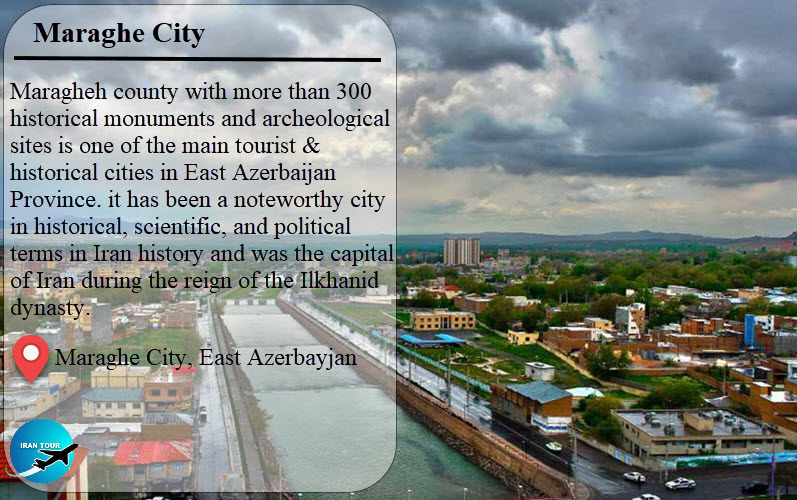 |
The garden city of Maragheh, due to its weather variety, can be considered as one of the most outstanding natural sites of Azarbayjan. Its valleys full of heavenly-smelled flowers spread as an emerald carpet, its virgin nature with its high mountains and preserved natural sites have all created a unique attraction. Its green areas with marvelous trees and rare fruits have added to its beauty to a degree that all observers share the kind of sensation that aroused in Holako, the Mongolian invader who was overwhelmed by Maragheh's beauty and chose it as the capital of a vast empire in order to gain spiritual peace in its heavenly gardens. Nowadays in spite of the development of the city and urban life, the old picture of Maragheh as a garden city is well preserved. Looking from the distance it is easily understood that the attribution of "Garden City" precisely fits with the green environment of the city. Being located on the southern slopes of the Sahand, with its mild humid weather, Maraghe is now a major attraction among all nature lovers and hosts plenty of quests each year from all over the world, especially in the spring and summer seasons.
History
Based on ancient texts the history of Maragheh goes back to 2800 years ago. The name of the city was used for the first time in Orartoyee and Assyrian inscriptions. There is also evidence, such as the remnants of primitive human beings, that prove the existence of Maragheh in the second and third geological periods and also in newer eras that span between one hundred to two hundred thousand years old. There are also archeological findings that prove there has been fixed inhabitation in Maragheh during the Neolithic period (5000 - 6000 BC). In the time of the Parthian Dynasty, the state center of Azarbayjan has been a city called Faraspa, which is believed by many researchers to be another name for Maragheh. During the Islamic period, Maragheh was considered an important political capital for Azarbayjan and various Arab and non-Arab rulers chose Maragheh as a center for their government. The historical remains can prove this. During the course of history, Maragheh has endured various ups and downs. Nowadays it contains more than 300 hundred historical monuments from various historical periods, out of which 110 has been officially registered Another point worthy of mentioning is that Maragheh is among the 10 cities in Iran that preserved the historical and architectural theme and texture. Traditional Houses, caravanserais, mosques, public bathrooms, Bazars, and squares still exist in the city. The historical identity of the Maragheh inhabitants is as well preserved and intact as its architecture. Due to these reasons, Maragheh hosts plenty of foreign tourists from all over the world each year.
Historical Sites
Fossils Zone
Millions of years ago and in the second and third geologic periods, before the eruption of Sahand, Maragheh was one of the habitats of gigantic animals. The discovered fossils including 32 species of mammals and 2 types of birds have made Maragheh the world's fossil paradise. According to many researchers and scientists, Maragheh is one of the main four regions of the world having evidence from primitives of the Stone Age (100 thousand to 200 thousand years ago). Of the 40000-hectare fossil zone of Maragheh, 1036-hectare has been verified as a national fossil monument. The excavations have revealed fossils of types of horses, rhinoceros, deer, giraffes, and elephants like Mastodont, Deinotherium, and Gigantism. A museum of paleontology and fossils is supposed to be built there and the models of prehistoric gigantic animals are going to be displayed.
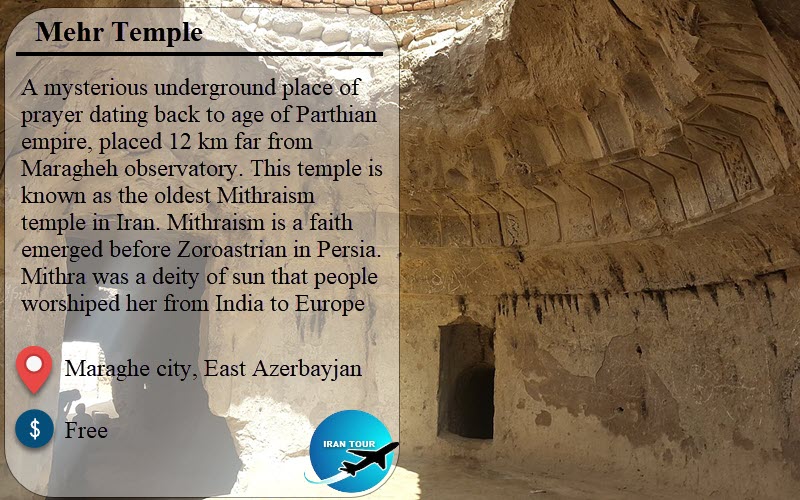 |
Mehr Temple
Mehr temple is one of the few existing Mithraism temples located within a 5 km distance in the south of Maragheh in a village called Varjovi. The stone structure of the temple is similar to Mithraism temples in Greece, Italy, and Turkey in many ways. In the walls of its grand hall, some verses from the Al-Imran Surah of the Quran are scripted in Sols and this means that this temple was later used by Muslims. On the left side of the wall at the entrance, an image of a snake is carved. These carvings were very popular in the Parthian Empire and can be seen in the plasterworks of that period very frequently. At the end of the Safavid dynasty or the beginning of the Qajar dynasty, a cleric called Molla Masoum of Maragheh was buried there. It should be noted that this temple is the oldest structure in the province.
IL-KHANIDS’ MUSEUM
The main building of the museum was built between 1974-1978 by the Association of National Monuments. The building was first used as the Primary Museum of Maragheh in 1984 and works of different historical periods were put on display. In 1996, the museum specialized in the Elkhanate period for it had been an important city in the period. Many works including pottery, ceramics, coins, metals, glassworks, and books as sources of information were collected and brought there for the joy of the public and specialist viewers.
Collection of pottery: the art of pottery in the Il-Khanid dynasty can be named the golden age of pottery in the Islamic era. Important features of the works of pottery in this era are different techniques and diverse designs.
Collection of coins: the coins in the Il-Khanid Museum are one of the most complete collections of coins from the Il-Khanid dynasty in Iran. Gold coins were minted for special occasions like festivals and eves and copper coins were used in daily trades. The Maragheh, Tabriz, and Soltaniyeh mints were the biggest minting centers of the period.
Collection of glassworks: since many glassworkers of the period fled to Egypt and Syria, glassworking failed and the works found in the museum are of great importance and rarity having different decorations of glasses for that period.
Collection of metals: in the metal section of the museum, great metalworks of the Elkhante era including metal dishes, gunmetal lights, and bronze candle holders are on display. These works were made by molding, carving, and damascenes. The strength of these works is displayed by the animals' legs and the light is demonstrated by the wings of birds. This museum also holds a sword having gilt on gunmetal and ivory belonging to Kari Khan bin Bahador Khan the king of Dagestan.
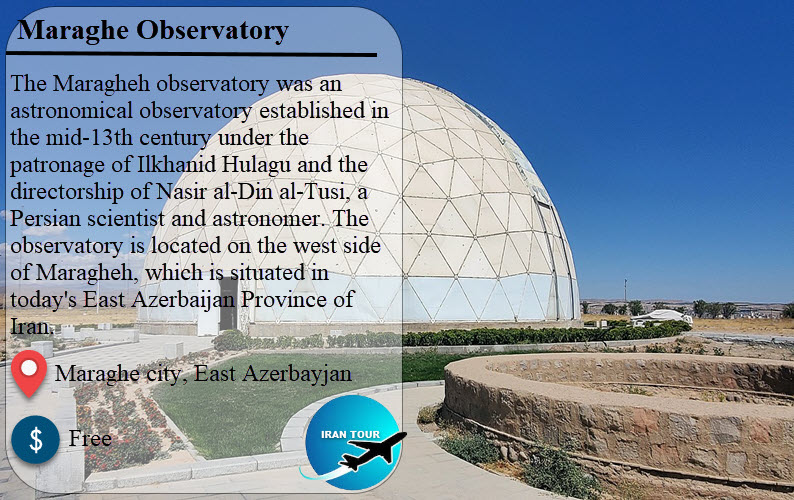 |
Observatory
Maragheh has always been one of the observatories and astronomical research centers. This complex is located a 2 km distance in the west of Maragheh on a hilltop called Rasad Daghi (Observation Hill). According to historical books, the construction of the observatory began in 1261 AD by Hulagu Khan and his wise minister Khaje Nasir-alDin al-Tousi. Many prominent figures like Ghotb-olDin Fakhr-al-Din Maraghi, Mohiy-ol-Din Maghrebi, and... contributed to the construction of the observatory. The completion of the construction took 15 years and according to Hulegu's order, many books and astronomical equipment taken after the occupation of Baghdad were brought there. Archeological digs have revealed different parts of the site including the observatory, central tower, round quintet units, and the library and it was built 157 years before the Samarkand Observatory. Considering the astronomical activities conducted there, it could be said that it was the most complete one of its time and the best one before the invention of telescopes. All the data collected without telescopes had been collected there. It was not until after 300 years that an observatory of that quality was built in the West. A Dome has been built on the site to protect it recently and in the near future, an exhibition of equipment and instruments will be set up there.
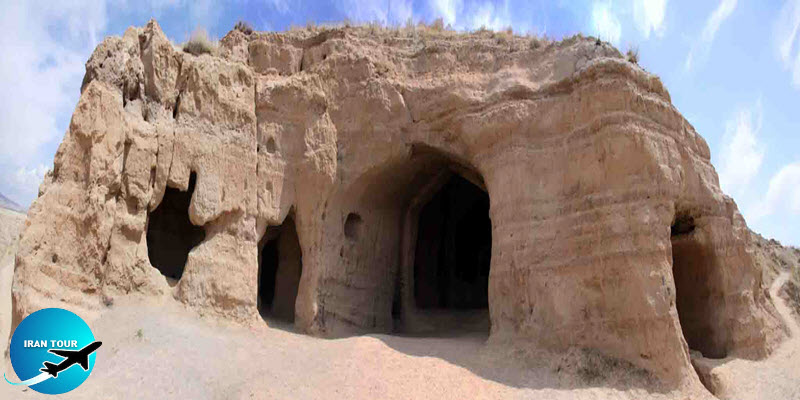 |
Rocky Architecture Of Observatory
In the lower parts of the hill, there exist a collection of man-made caves opening to the southwest. These caves are carved in the mountain with vaults and have several holes. Many theories have been advanced about them. Some believe they were built in the pre-Islamic era as temples and some others connect them to Buddhism.
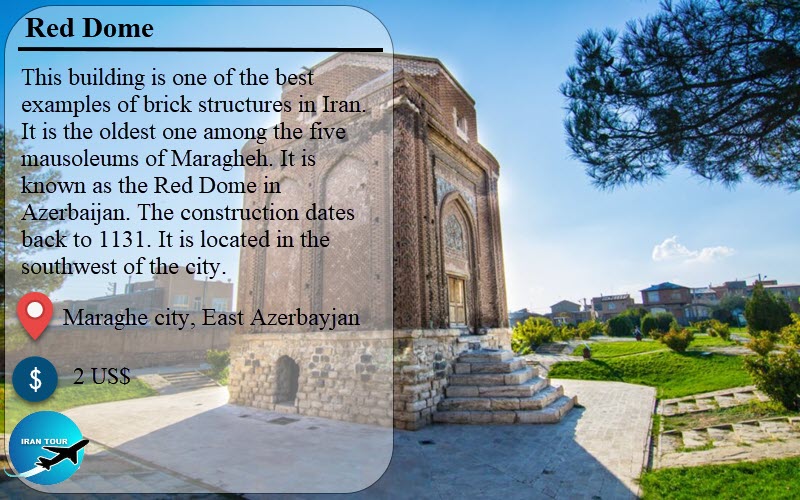 |
Red Dome
The oldest
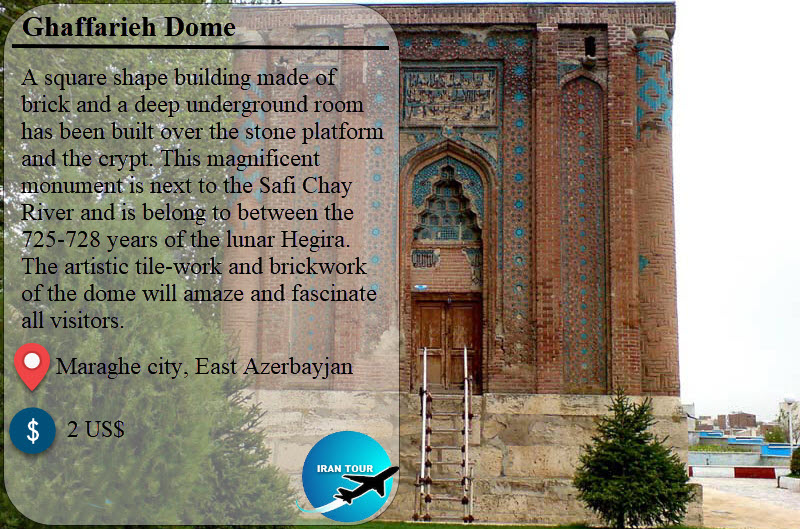 |
Ghaffaria Dome
The historical Ghafariyeh Tower in the North West Maragheh was built at the time of the Ilkhanate king, Sultan Aboo Saeid Bahador Khan. The reason for its name, according to historical texts, is that a mystic named Nezam-ol-Din Ahmed Bin Hussein Ghaffari built an edifice on his way back from Haji and vowed it and the nearby estate at the time of the Sultan Yaghub Bin Hassan Beig Agh Ghoyounloo. And this gave the name Ghafariyeh to this building.
Ghafariyeh tower was built modeling the Red Dome and is a square brick construction built on a platform and over a tunnel. Its four corners are decorated with brick ornaments. Its entrance is toward the north and has one big fatte and two narrower but taller ones on both sides. Above all crescents of the vaults, beside the script, there is a margin having the shape of two symmetric bats. Since this sign is attributed to Amir Shams-el-Din Ghara Sanghor, it could be supposed that the tomb belongs to Ghara Sanghor-al-Charkasi alMansoori, one of the Egyptian governors, who was killed by Sultan Abu-Saeid in 728 Hijri to gain the attention of Al-Malek ol-Naser and then was buried in the same tomb built by Ghara Sanghor while living.
Blue Dome
At a 10-meter distance from the Round Tower, a decagonal tower is shining.
This dome is called the Blue Dome and is the burial place of Hulegu's mother (Doghooz Khatoon). Some attribute it to the Seljuk era and believe it was built in 593 Hijri. This dome must have been built between the year the tomb called Momeneh Khatoon was built in Nakhichevan and the Hulegu's conquering of Maragheh. On the upper side of each vault, three lines of muqarnas can be seen. Turquoise blue ceramics are used somehow in the same order in the outer part. The Blue Dome is almost similar to other tomb towers in Maragheh. This means that has a tall hall built on a stone base and a cellar in between.
Below the dome, a plasterwork script can be seen going around the tomb. This script is written in Naskh and presents the first verse of the 67th Sura of Quran. Under the main vault, the cellar is located and on its southern wall, the 26th and 27th verses of the 55th Sura is written.
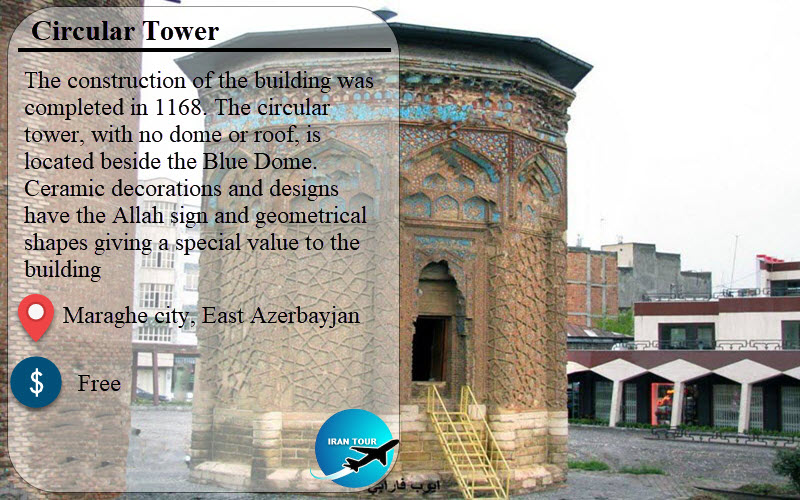 |
Round Tower
10 meters away from the north of the Blue Dome, the Round Tower is located. According to a Kufic script, the tower was built in 563 Hijri. However, the builder, or the one buried, nothing is known. The building has a simple view and has two floors: the cellar and the above room. If there has been a tomb in the cellar, the signs have been deleted over the years. The entrance has a crescent-shaped vault like the Red Dome surrounding the entrance. Below this vault, a Kufic script can be seen with complex designs of turquoise ceramics and bricks. Ceramic decorations and designs have the Allah sign and geometrical shapes giving a special value to the building
Molla Rostam Mosque
Next to the Molla Rostam Square, one of the most beautiful mosques in the city or even the region is located. This mosque has the same name as the square. The main building of the mosque is divided into three parts: 1) the main ancient and big hall, 2) the votive distribution in the north of the main hall, and 3) the small winter hall. The interesting point about the lighting of the mosque is that the light inside is adjusted to the need of a human at that time of the day. It is not too light to bother the eyes or too dark to bore the people. The most important attraction of the building is the beautiful decorations on the poles, beams, and under the ceiling creating a different atmosphere compared to other mosques of the city. The 35 columns of the mosque are made of populous and located on simple stone bases. Above them, there is a three-layer shape growing bigger from the bottom to the top. No script has been found revealing the date of construction of the mosque and no book has mentioned the date but it must not have been built before Safavid Dynasty and in the time Shah Tahmasb was ruling the country i.e. the mid-tenth Hijri century.
Zarir Mosque
Zarir mosque, just like most of the other wooden mosques in Maraghe, was built during the Safavid Dynasty. The creativity of design, and balanced harmony with nature, climate, and cultural conditions are easily seen in this mosque. Rowed columns have joined the earth to the heavens and have created a nice spiritual atmosphere for religious services. Colorful decorations on the woods and ceilings, with flowers, have made a soft pretty scene. Rowed and painted columns from the bottom to the top have got larger and the vertical trend causes the column to seem shorter. This trick has caused the tall scary columns to look more friendly and soothing.
Portal Of Sheykh baba Mosque
It can be understood from the
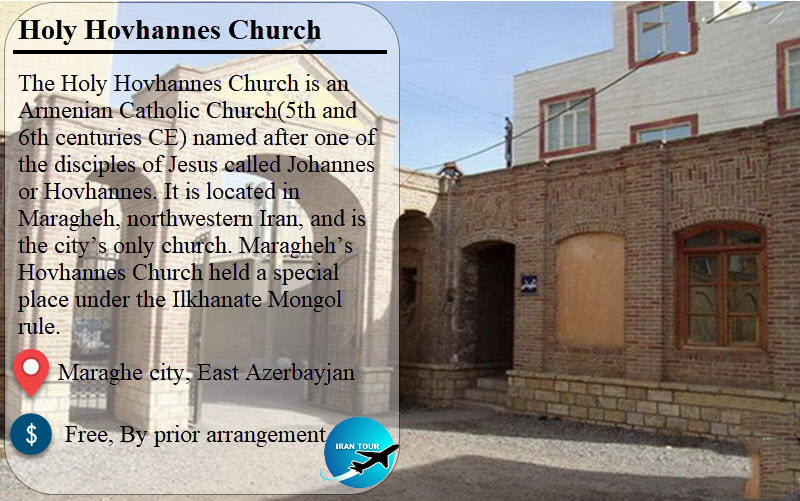 |
Hovanes Church
The Howans church is the only remaining church in the city and although there are no Christians living there, it is one of the most respected and important symbols of divine religions. Since the Ilkhanate era was an era of ease for religions, the church was built then and after that time, some modifications were done to it. This building includes a Christian school, the house of the priest, and the watcher's house. The church has an altar, an apron, and a middle section. The altar was for the priest, the middle section was for the priest's relatives and the apron was for common people. The tower of the mission bell includes four columns with a cone on top.
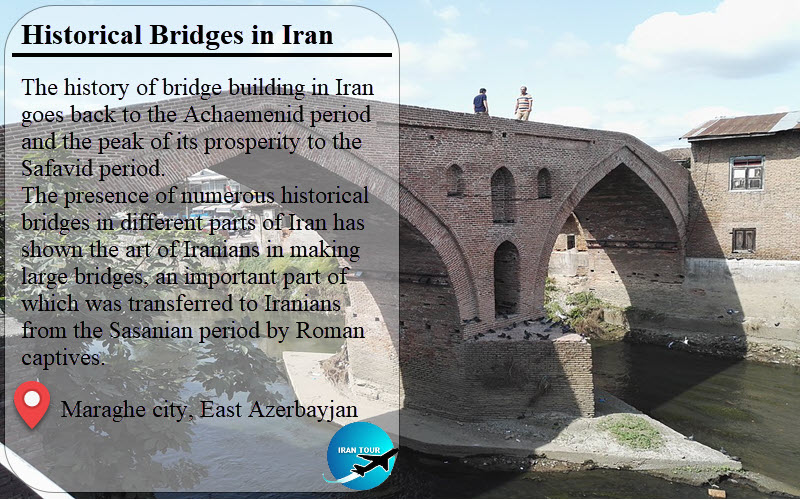 |
Ancient Bridges
The most famous old bridges in Maragheh are the Mordagh Bridge, Khanghah Bridge, and the Hesam Ol-Dowleh Bridge. One of the masterpieces of architecture from the Safavid era is the Mordagh Bridge having three openings and lets the Mordagh River go by. The name of the bridge comes from the name of the village in which the bridge is Built.
The Khanghah Bridge has levees made of a special stone called Sendjan. The main body of the bridge is built of red rectangular bricks. This bridge has a script revealing the name of the builder as a man called Haji Mohammad Bagher and the date of the building as 1030 Hijri.
On the old road from Maragheh to the observatory, there is a bridge built on a torrent hill. This bridge has a crescent vault and is made of bricks with stone bases vertically. The bridge was called the Hesam-ol-Dowleh Bridge after its reconstruction in the Qajar period.
- Details
- Category: Where to go in IRAN